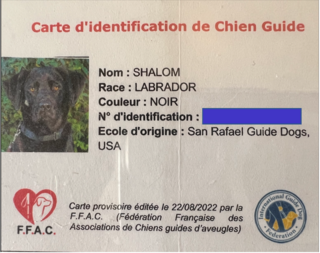Traveling With a Guide Dog: Advice from a Seasoned Traveler
Beacon Stories
International Guide Dog Day, April 26th, is extra special to Janni Lehrer-Stein, as she’s celebrating the 5th anniversary of graduating with “the world’s best guide dog,” Shiloh. Janni, who has retinitis pigmentosa, has traveled to five countries outside of the United States with Shiloh and is sharing advice for traveling with a guide dog.

Janni and Shiloh on a cobblestone street with buildings on both sides.
International Guide Dog Day, April 26th, is an opportunity to celebrate the work of guide dogs around the world and raise awareness about the importance of guide dog services to help people who are blind or have low vision live independently.
This day is extra special to Janni Lehrer-Stein, as she’s celebrating the 5th anniversary of graduating from the Guide Dogs for the Blind with “the world’s best guide dog,” Shiloh. In their five years together, Janni and Shiloh have traveled domestically often and to five countries outside of the United States.
Janni was diagnosed with retinitis pigmentosa (RP) at the age of 26 in 1982 while living in Washington, D.C., pursuing her career in law. Soon after her diagnosis, Janni and her husband, Lenny, decided to relocate to San Francisco, California, as it’s a much more walkable and accessible city. They’ve continued to reside in San Francisco ever since, raising their three children.
Since her diagnosis with RP, Janni has been involved with the Foundation Fighting Blindness through the local Bay Area Chapter and participated in the first “Walk for Sight” event, now known as the VisionWalk. Nationally, Janni has served as a trustee since 2010 and is now a member of the board of directors, serving as chair of the accessibility task force. Now that Janni is a retired attorney, she currently spends most of her time focused on disability rights advocacy and was recently appointed by President Biden to the Committee for the Preservation of the White House. With her ever-busy lifestyle, it was challenging to find the right time to get a guide dog.
“Guide dogs are a very serious responsibility,” says Janni. “They become a member of your family, but you’re also responsible for keeping them safe and well. There are many demands that come with a guide dog, but the rewards make it so worthwhile. You’re forever a team.”

Janni holding a crepe with Shiloh next to her.
Janni was matched with her guide dog Shiloh through the organization, San Rafael Guide Dogs for the Blind. After an intense application process, Janni stayed on their San Rafael campus for two weeks of training, which included acclimating to the grounds and trainers for two days and then, on the third day, meeting her guide dog.
“I’ve met and worked with the President of the United States, and yet I was as nervous and excited as I’d ever been to meet my guide dog,” says Janni. “I had requested a dark-colored dog because I still have some light-dark differentiation, so it’s easier for me to see my dog against the light pavement. And what I got was this perfectly trained, calm black lab. I’m so grateful to Shiloh’s foster family who helped raise him.”
It took a lot of hard work and time to build trust with each other, but now, Janni relies on Shiloh daily and credits him for her independence, especially when it comes to her travels. Janni and Shiloh cross busy streets, take public transportation such as the bus or subway often and even fly across the country and internationally by themselves.
Janni and Shiloh navigate through the airport crowds and barriers, find the correct gate, and board the airplane. At 60 pounds, Shiloh has learned to squeeze himself under the seat in front of Janni for the flight and knows it’s his only job to stay seated until he receives further instructions.
“Shiloh’s extremely alert when we’re traveling, which proves that he understands the potential dangers,” says Janni. “People who can respect that a guide dog or service dog is working when traveling are really doing a great service for the disabled person by understanding that’s what is necessary.”
Traveling internationally with a guide dog is a vastly different experience as well. Janni is a lifelong student of history and culture, and she finds it so exciting to visit a city or country she’s never been to before. So having Shiloh to travel to new countries with has been extremely helpful for Janni.

Shiloh’s Guide Dog identification for France.
Before traveling anywhere internationally, Janni always makes sure she understands what the rules of the country may be in terms of accessibility and also for admission into the country with a guide dog. As part of her essential research, Janni does a Google search on “entry regulations for service dogs” in each country to find out what is required. Janni also suggests contacting one of the many international guide dog organizations, as they’re the experts on what may be required when traveling. And as with domestic travel, Janni recommends always traveling with all your guide dog documentation that is legally required to ensure you’ve complied with all the requirements to enter a foreign country.
Janni also notes that culturally, guide dogs are accepted differently in every country. In Japan, they have less than 1,000 guide dogs in the entire country. So, in addition to doing research on how to enter the country with a guide dog, Janni values the importance of the culture in that country as well and tries to let places she’s visiting know ahead of time that she’ll be there with her guide dog.
“Traveling with a guide dog, domestically or internationally, you come across people who are fearful, probably because they just don’t know or understand,” says Janni. “So we take the necessary extra steps to advise people every place we travel that we will be visiting with a guide dog. Sometimes even that is not enough, though. It can help when people are educated on what a guide dog can do, and you can then tour a country just like anyone else.”
Janni is also an avid student of language, so before visiting a new country, she learns the basic vocabulary in that native language to at least be able to state, “I am blind” and “this is my guide dog.”
“As a person with a disability, we have to advocate every second of our lives,” says Janni. “There have been times, whether domestic or international, when we will run into someone questioning entry because of my guide dog. And even when you plan ahead, you have to be flexible and have a backup plan, as things may not always go the way you want them to. It’s important for travelers with guide dogs to know the rules, abide by them, and sometimes, expect that others will not follow the law and demand more than is necessary or refuse entry outright. I’ve learned that when I say, “This is my ADA-certified guide dog who is necessary for me to navigate. Wherever the public is permitted, we are also authorized to enter,” that usually resolves the situation, and things work out.”
Although Janni admits traveling with a guide dog can be challenging and takes a lot of preparedness and advocating on her part, it’s completely worth it and even makes her travel experiences even better.
“What I love most about traveling with Shiloh is that he’s removed the element of fear for me,” says Janni. “He’s built my confidence about my ability to go to places I’ve never been before. And Shiloh loves it too; he gets so excited when I pull my suitcase out, and sometimes he’ll put a toy in there all by himself. Shiloh makes his gratitude known with many kisses of thanks.”
-
.png)
Janni and Shiloh posing outside of a historic building.
-

Janni, her husband Lenny, and Shiloh posing at the top of a building overlook.
-
.png)
Janni, Shiloh, and her family in front of a historic building, Blenheim Palace.
-
.png)
Shiloh lying down at Janni's feet while flying.




